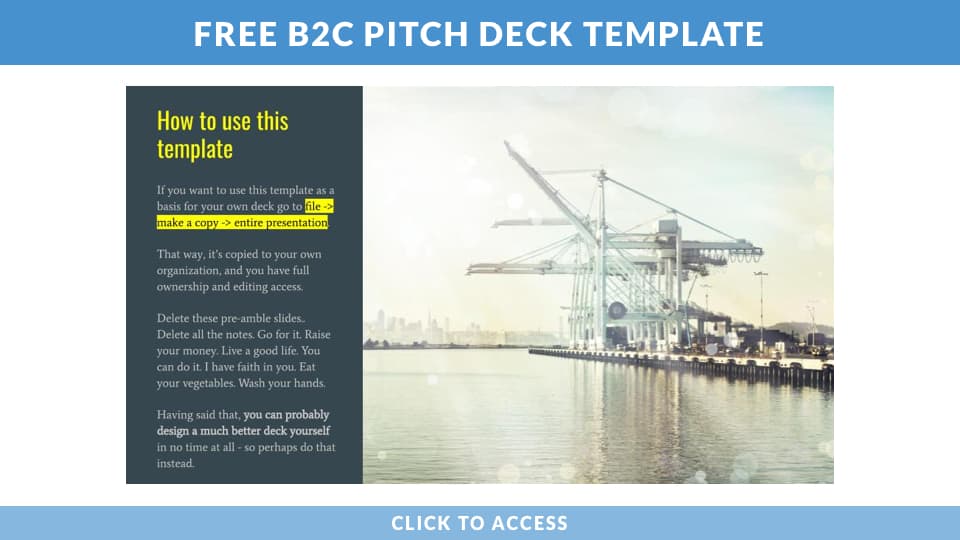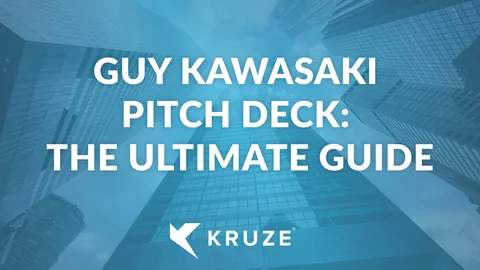
At Kruze Consulting, we’ve advised startups that have collectively raised over $15 billion in venture capital funding.
One tool we’ve found consistently effective is the Guy Kawasaki Pitch Deck template. It’s an excellent starting point for crafting your pitch to investors, and we suggest it as a template for many early-stage companies. When you’re crafting your pitch, you’ll need some materials, like a financial model. That will help you with VC due diligence. If you need more financial expertise, Kruze has fractional CFOs who can help you.
This guide will walk you through Kawasaki’s approach and how to use it effectively.
How to get the Guy Kawasaki’s deck
Visit Guy’s site directly to get the deck here. Below I’ll put on my VC hat (I was a VC at a couple of firms and have invested in over 80 startups at this point, and my clients have collectively raised over $2 billion or so) and I’ll walk through each slide in the deck to help you understand why it matters and how to use it to position your startup. We’ve also got other free resources that many founders use, including our top startup pitch deck templates article, our startup pitch deck course (with 8+ hours of video lessons), a startup operating plan slide, and several of our own free deck templates, which you can access for free right here:
What Is the Guy Kawasaki Pitch Deck?
Guy Kawasaki, a renowned Silicon Valley luminary, early Apple employee and investor, developed a pitch deck template that has become a go-to resource for many very early-stage startups. He emphasizes clarity, conciseness, and impact, making it particularly useful for entrepreneurs who need to capture the attention of busy investors.
The 10/20/30 Rule
At the heart of Kawasaki’s pitch deck philosophy is the 10/20/30 rule. Guy believes that an effective pitch presentation should:
- Contain no more than 10 slides
- Last no longer than 20 minutes
- Use a font size no smaller than 30 points
This rule is designed to keep presentations focused, engaging, and easily digestible for the audience. You really need to get investor’s attention, and this 10/20/30 idea helps keep you focused on presenting stuff that’s impactful. By limiting the number of slides and presentation time, it forces entrepreneurs to distill their ideas to their essence and cut the fluff.
My one addendum is that you should be able to deliver the pitch in 5 minutes, 10 minutes and 20 minutes. You never know when a meeting is going to start late or you are going to corner a VC at a networking event - so be ready to hit the highlights fast, and get them salivating to learn more in a follow up discussion.
Why Guy Kawasaki’s deck Is great for many startups
Guy Kawasaki’s pitch deck template has stood the test of time for a few important reasons. Here are three key reasons why it’s particularly effective for startups:
- It’s short: The deck’s brevity forces founders to distill their ideas to the core selling points. This is crucial when you’re pitching to busy investors who see tons of presentations – you need them to put their phones down. The 10-slide limit helps you keep your pitch focused and impactful.
- It’s flexible: While the deck has a suggested order, it’s not set in stone. You can move slides around to highlight your startup’s strengths. This adaptability allows you to customize the presentation to best suit your specific business and audience.
- It encourages storytelling: The structure of the Kawasaki deck naturally leads founders to tell a compelling story about their startup. More importantly, the way he’s written up each slide tries to push you to think more about the narrative vs. just regurgitating stuff, which can really make your pitch more compelling.
As a bonus point:
- It’s great for early-stage companies: This deck template is particularly well-suited for early-stage startups. Guy doesn’t really miss too much; It covers the essential elements that investors want to see.
The 10 Slides: Looking at each slide
Let’s explore each of the 10 slides in Guy Kawasaki’s pitch deck template, incorporating insights from our experience to understand their purpose and importance.
1. Title slide
The title slide is your first impression. It should clearly state your company name and provide a brief tagline or description of what your company does. As Guy Kawasaki suggests, this slide sets the stage for your entire pitch.
2. Problem/opportunity
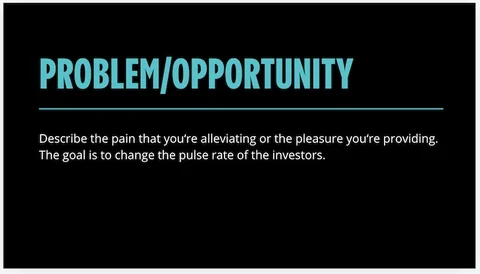
This slide articulates the problem your startup aims to solve or the opportunity it seeks to capitalize on. You are setting the stage for your entire pitch. Guy really wants you to articulate the problem or opportunity in a way that’s relatable to the VC and shows why it matters. If you fail here, then the VC probably doesn’t think you’ve got a leg to stand on!
Make it easy for the VC, who may not be familiar with your industry, to understand why a buyer would want to purchase your solution. However, be prepared to go deeper if the VC has experience in your industry.
Pro tip: Consider highlighting the problem using a specific, named client. This makes the slide more impactful and sets up a powerful narrative for later slides. I’ll discuss how this helps in a moment.
3. Value proposition
Your value proposition succinctly explains how your product or service solves the problem or capitalizes on the opportunity. This is your chance to show why you’re unique and why your solution makes sense in the market.
4. Underlying magic
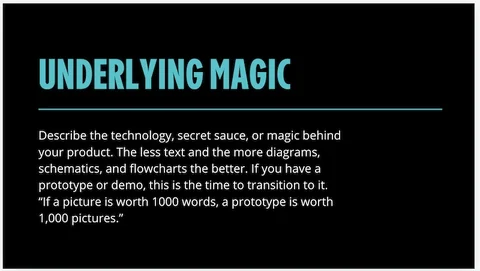
This is where Guy suggests including a demo, but the real goal is to showcase your competitive advantage. It’s an important slide for storytelling and convincing the VC that you’re truly special.
It’s a good idea to tie this slide to the problem slide by using an actual client example. Explain how this specific client was experiencing the problem, how your solution provided value, and then demonstrate the “magic” of your product. Instead of just clicking through features, show what the client did that drove real value. Really, really resist just doing a demo like you would on a sales call – you are selling equity, not the actual product! A storytelling approach makes your pitch way more memorable and proves to the VC that you have real, satisfied customers.
5. Business model
This slide explains how you make money. Outline your revenue streams and pricing strategy. While investors understand that pricing may evolve, they want to see a high-level view of your charges. Is your solution $250,000 a year or $10 a month?
This information also sets the stage for your go-to-market slide, helping investors understand what sales and marketing approaches you can realistically use.
6. Go-to-market strategy
Here, you’ll explain how you plan to reach your customers. This strategy should align closely with your business model and pricing structure you outlined in the previous slide. It’s hard for really early stage companies to have a lot thought out on this slide, so be prepared for a discussion.
7. Competitive analysis
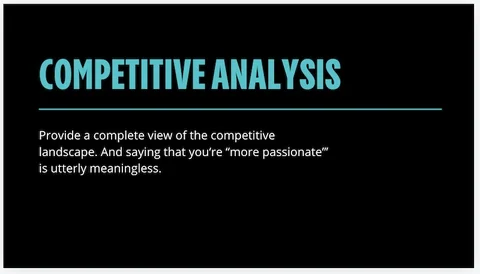
This slide is crucial for demonstrating your understanding of the market landscape. Don’t shy away from mentioning big competitors – they prove there’s a significant market. Sometimes, big, lazy competitors present great opportunities to steal market share. And you don’t want to leave off competitors, as it makes you look like you don’t know the market. So lay it all out there.
Use this slide to your advantage. While you shouldn’t simply criticize the competition, do prove that there’s a substantial market with customers willing to spend money on solutions like yours. This is a great way to showcase again how you are better, especially if you won some of your clients away from the competition.
8. Management team
Introduce the key members of your team and highlight their relevant experience and achievements. Guy places this slide later in the deck, believing that if you haven’t captured the VC’s attention by now, the management team won’t matter. However, if you have a particularly impressive team, move it closer to the front.
9. Financial projections
Present several years of projections here. The key is to show that you’re thinking big. Make it clear that your business is venture capital-bankable and has significant growth potential. Don’t model yourself out of an investment by being too conservative, but of course, don’t show yourself being bigger than Google unless you really think that’s going to happen.
10. Current status
Conclude with your current status, key accomplishments, and intended use of funds. While it’s challenging to fit all this information on one slide, it provides a strong wrap-up to your pitch.
Remember, each of these slides plays a role in telling your startup’s story and convincing investors of your potential. Try to maintain a cohesive narrative throughout your pitch, using specific examples and client stories where possible to make your presentation more engaging and memorable.
The Impact of a Well-Crafted Pitch Deck
A pitch deck following Guy Kawasaki’s principles can significantly impact your fundraising efforts. It can:
- Capture investor attention: The concise format ensures you communicate your key points before losing your audience’s interest.
- Demonstrate preparedness: A well-structured deck shows investors you’ve thought critically about all aspects of your business.
- Facilitate meaningful discussion: By covering all essential topics, your deck sets the stage for in-depth conversations with potential investors.
- Serve as a powerful leave-behind: After your presentation, your deck continues to work for you as a reference document for investors.
Applying the 10/20/30 Rule in Practice
While the 10/20/30 rule provides a solid framework, its application requires some finesse. Here are some tips for making the most of Kawasaki’s approach:
- Keep it visual: Use high-quality images, charts, and graphs to illustrate your points. Visual elements can convey complex information quickly and effectively.
- Practice your timing: Aim to present your deck in 15-18 minutes, leaving room for questions and discussion.
- Be prepared to adapt: While your deck should follow the 10-slide structure, be ready to dive deeper into specific areas based on investor interest.
- Tell a compelling story: Connect your slides into a cohesive narrative that takes investors on a journey from problem to solution to market opportunity.
- Focus on key metrics: For VC-backed startups, emphasize metrics that demonstrate growth potential and market traction.
Conclusion - Why Guy Kawasaki’s desk is great for many founders
The Guy Kawasaki Pitch Deck template, with its 10/20/30 rule, provides a powerful framework for entrepreneurs to effectively communicate their vision to investors. By following this structure and focusing on clear, concise, and compelling content, startups can significantly improve their chances of securing funding and building successful businesses.

Kruze works with venture capital backed startups, providing accounting, bookkeeping, tax and finance/fundraising advice. Our clients have collectively raised billions in startup funding, and we’ve published tons of resources that may be helpful on your entrepreneurship journey. Check out our VC due diligence checklist, or learn how VC firms make money or just reach out to us!

